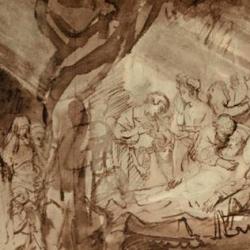Westminster OT professor Pete Enns has been a friend since he taught me German at seminary nearly twenty years ago, and as editor of the Westminster Journal he regularly published my work. I have raised questions to him in private in the past, and we have had our friendly disagreements. I offer the following public responses to his ETS in the same spirit of friendship.
Pete gave a provocative talk to a crowded room on the “incarnational” model of Scripture, drawing on Warfield, A. A. Hodge, Ridderbos, Bavinck, and C. S. Lewis for support. Much of Enns’s project is to emphasize that the Scriptures are a thoroughly human, as well as thoroughly divine, set of writings, a regular theme of the Princeton-Westminster tradition. He made some excellent points about the apologetic problems that arise when the human character of Scripture is ignored.
But I’m suspicious of a few things.
First, I’m suspicious of the claim, made by CS Lewis and countless others, that the Scriptures display an “incarnational” character in their “unliterary” quality. After a couple of decades of literary analysis of the Bible, it surprised me that Peter still appeared to endorse this conclusion. As Robert Alter and many others have argued, the conventions of the Bible’s literary artistry are, of course, different from those of Aeschylus, not to mention Henry James, but that doesn’t mean the Bible is any less artistic.
This may seem a minor point, but much of the rhetoric of Enns’s incarnational model depended on the supposedly “weak” and “fragmented” and “gashed” and “broken” character of Scripture. No doubt there is something to this, but I would have thought it well proven that the Bible is also a grand unified artistic narrative. It felt as if his incarnational model was still haunted by some theology of glory; because the Bible doesn’t measure up to some standard of literary unity or excellence, it appears broken and fragmented and literarily weak, and the incarnational analogy helps to explain how it can still be considered divine. Pete wants to insist that the Bible itself, its actual form and contents, define what “infallibility” means; I’m with him all the way there. But why not let the Bible itself, its actual form and contents, define what “literary excellence” or “literary artistry” means? It felt that Pete was importing some extra-biblical standard of artistry and then trying to work out the problems that arise when the Bible doesn’t measure up.
It also feels (I’m deliberating using emotive language here) that he’s doing the same thing with some of the Bible’s factual claims. He wants the Bible to define what historical factuality means; again, I’m with him all the way. But his incarnational analogy (at least, the particular uses to which he puts this analogy) appears to be necessary only if the Bible doesn’t measure up to some extra-biblical standard of historical facticity.
Second, Pete rightly noted that claiming infallibility in “what Scripture teaches” raises the question of what Scripture does in fact teach. But at one point he seemed to distinguish between portions of Scripture that “teach” and portions that don’t, and wondered what we are to do with those parts that don’t teach. This point is a variation on the earlier complaint: He seems to be coming to the text with some assumptions about what “teaching” involves – how else could he distinguish between teaching and non-teaching passages (unless the Bible indicates somehow when it’s in teaching mode and when it’s not, which doesn’t appear to be the case).
He didn’t explain what his distinction of “teaching” and “not-teaching” passages involve (if I understood his point correctly), but perhaps this question focuses things: Does the Bible teach that Moses wrote down the law? The Bible certainly states this (Exodus 24:4; 31:9). But is the Bible teaching it? I’m not absolutely certain how Peter would answer this, but my suspicion is that he would say No. If that’s right, how does he know? Or, does the Bible teach that Adam lived 930 years? It certainly states it, but is that a “teaching” passage? And how can we tell?
Pete admitted that the incarnational analogy with Scripture is, like all analogies, limited. Models break down. But that’s not the main source of my suspicion. The main source is that the incarnational analogy is, in itself, too vague to do much work. It helps to highlight the humanity of Scripture, but then what? What does it mean for Scripture to be a human document? And what does it mean in detail?















